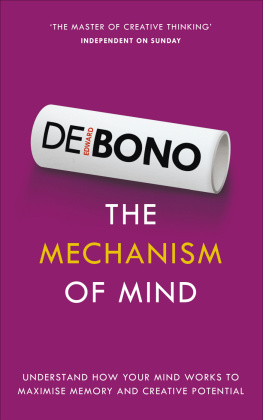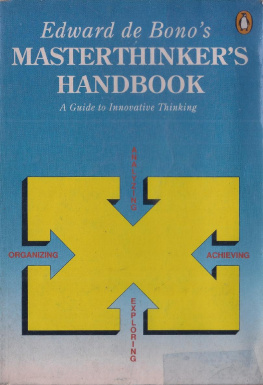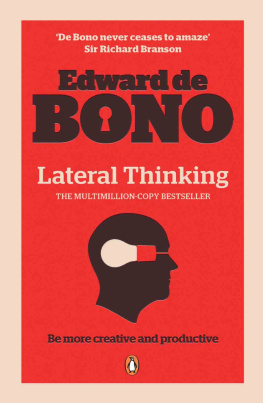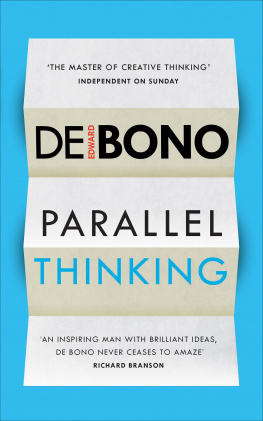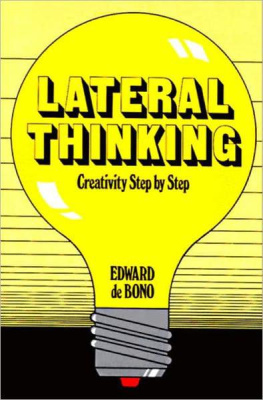Edward de Bono - Lateral Thinking: An Introduction
Here you can read online Edward de Bono - Lateral Thinking: An Introduction full text of the book (entire story) in english for free. Download pdf and epub, get meaning, cover and reviews about this ebook. year: 2014, publisher: Ebury Publishing, genre: Politics. Description of the work, (preface) as well as reviews are available. Best literature library LitArk.com created for fans of good reading and offers a wide selection of genres:
Romance novel
Science fiction
Adventure
Detective
Science
History
Home and family
Prose
Art
Politics
Computer
Non-fiction
Religion
Business
Children
Humor
Choose a favorite category and find really read worthwhile books. Enjoy immersion in the world of imagination, feel the emotions of the characters or learn something new for yourself, make an fascinating discovery.

- Book:Lateral Thinking: An Introduction
- Author:
- Publisher:Ebury Publishing
- Genre:
- Year:2014
- Rating:5 / 5
- Favourites:Add to favourites
- Your mark:
- 100
- 1
- 2
- 3
- 4
- 5
Lateral Thinking: An Introduction: summary, description and annotation
We offer to read an annotation, description, summary or preface (depends on what the author of the book "Lateral Thinking: An Introduction" wrote himself). If you haven't found the necessary information about the book — write in the comments, we will try to find it.
Lateral Thinking: An Introduction — read online for free the complete book (whole text) full work
Below is the text of the book, divided by pages. System saving the place of the last page read, allows you to conveniently read the book "Lateral Thinking: An Introduction" online for free, without having to search again every time where you left off. Put a bookmark, and you can go to the page where you finished reading at any time.
Font size:
Interval:
Bookmark:
Contents
Why do some people always seem to have new ideas while others of equal intelligence never do? Lateral Thinking is Edward de Bonos original portrayal of what lateral thinking is, how it works and how to use it to develop your own potential for thinking and problem solving.
First published in 1967 as The Use of Lateral Thinking, this classic international bestseller remains as relevant to learning, problem solving and creative thinking today as when it was first published. De Bono argues that conventional vertical thinking often inhibits our ability to solve problems and come up with new ideas. He then shows that lateral thinking is a far easier and more natural way to generate simple, sound and effective ideas and offers guidance on how to develop your own ability to think laterally. Lateral thinking is a technique that anyone can learn and benefit from.
Edward de Bono studied at Christ Church, Oxford (as a Rhodes Scholar). He also holds a PhD from Cambridge and an MD from the University of Malta. He has held appointments at the universities of Oxford, London, Cambridge and Harvard.
In 1967 de Bono invented the now commonly used term lateral thinking and, for many thousands, indeed millions, of people worldwide, his name has since become a symbol of creativity and new thinking. He has written numerous books, which have been translated into 34 languages, and his advice is sought by Nobel laureates and world leaders alike.

The term lateral thinking was invented over forty-five years ago with the first publication of this book and the theory is as relevant today as it was then, perhaps more so. It was coined to emphasize a method of thinking that encouraged the brain to originate new ideas through an easy and natural way of creative thinking, separate and contradictory to the more generally lauded power of logical or vertical thinking. From the moment we begin our formal education, we are taught to think by proceeding logically forward indeed we are often rewarded for doing so. Problem-solving skills are taught to us from an early age, usually through a systematic formula of reading, analysing and resolving situations by following a sequence of steps. The creation of new ideas that are simple and effective the two aims of lateral thinking would seem to follow naturally but in fact this vertical thinking can be a positive inhibitor of such new ideas. Lateral thinking allows the answer to a problem or a new invention to come about from a non-sequential thought process or by viewing a situation from a different angle.
Creativity and innovation are our greatest means of progress but they need people who are prepared to look for alternative routes to an answer, to look for answers to different and difficult questions, to look away from the obvious methods of thinking. Breakthrough ideas are not restricted to those of a particular intellect; they are achievable for every person, young and old. Lateral thinking is a skill that can be acquired just the same as an ability to ride a horse or bake a cake. In a time when business is highly competitive, required to react to fast-moving trends and to accommodate the challenge of the current economic market, the ability to conceive innovative solutions and effective strategy is essential. An enhanced ability to think is a basic tool for professional and personal success and a tool that is open to everyone.
Since this book was written, I have been fortunate to teach this type of thinking to thousands around the globe from young children to high-profile business veterans, including expert scientists, engineers, designers and architects. It applies to and benefits all. This introduction to lateral thinking identifies the methods by which to recognize lateral thinking and guidance on how to initiate and develop lateral thinking in your own life. It affirms the aims and purpose of lateral thinking and encourages the reader to develop lateral thinking as a habit, to broaden their potential.
Edward de Bono, 2014
Why do some people always seem to be having new ideas while others of equal intelligence never do?
Since Aristotle, logical thinking has been exalted as the one effective way in which to use the mind. Yet the very elusiveness of new ideas indicates that they do not necessarily come about as a result of logical thought processes. Some people are aware of another sort of thinking, which is most easily recognized when it leads to those simple ideas that are obvious only after they have been thought of. This book is an attempt to look at this sort of thinking and to show that it is quite distinct from logic and often more useful in generating new ideas. For the sake of convenience, the term lateral thinking has been coined to describe this other sort of thinking; vertical thinking is used to denote the conventional logical process.
To trace fully what goes on in the mind, all its activity ultimately needs to be translated into patterns of excitation in the nerve networks of the brain. Relatively little is known at present about the detailed workings of the brain, yet it is possible to entertain a broad concept of its organization. Just as the functional organization of the electric circuit in a house may be appreciated without details of the layout of each wire or the design of each switch, so an understanding of thought processes may be approached by examining the outward manifestation of the mind for evidence of underlying systems. A system analysis of this kind would consider, for example, the effects of a complex interaction of positive and negative feedback.
Such a view of brain function, however, serves only as a convenient model for the development of the concept of lateral thinking. Even so, the usefulness of lateral thinking does not in any way depend on the validity of the model. Supposing the model is valid, it would be as irrelevant to the skilful use of lateral thinking as a knowledge of engineering is to the skilful car driver. No one would suggest that the proper use of logical thinking has depended on a full understanding of the behaviour of the brain.
The notions expressed in this book, therefore, are based on simple observation and on a certain concept of the functional organization of the brain. Ordinary terms such as thoughts, ideas and perceptions are used, as these terms seem to make most sense in this context.
Lateral thinking is not a new, magic formula but simply a different and more creative way of using the mind. The New Maths makes good use of lateral thinking, the psychedelic cult is an abuse of it. The New Maths is specially apt as an example because, in place of the old fixed approach to mathematics, it substitutes a direct involvement of the pupil, giving him a more personal sense of achievement. This encourages much greater flexibility of mind, for the pupil is actively encouraged to consider a problem from many different points of view, and to appreciate that there may be several ways of reaching a correct conclusion. In time the same principles, which are all basic to lateral thinking, may come to permeate other fields of learning.
After reading this book some people will recognize lateral thinking as something that has been glimpsed tantalizingly now and then; occasions may be recalled when brilliant results have been obtained by using it. No textbook could be compiled to teach lateral thinking, although in the following pages it is suggested how certain techniques might be consciously applied to help break the stranglehold of logical thinking. The idea here is to show what lateral thinking is and how it works, and then to stimulate readers to develop their own potential for thinking in this manner.
Next pageFont size:
Interval:
Bookmark:
Similar books «Lateral Thinking: An Introduction»
Look at similar books to Lateral Thinking: An Introduction. We have selected literature similar in name and meaning in the hope of providing readers with more options to find new, interesting, not yet read works.
Discussion, reviews of the book Lateral Thinking: An Introduction and just readers' own opinions. Leave your comments, write what you think about the work, its meaning or the main characters. Specify what exactly you liked and what you didn't like, and why you think so.

